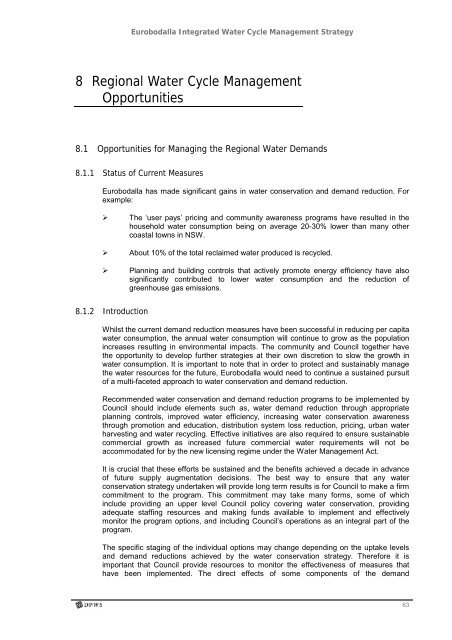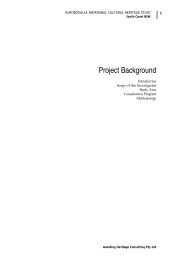Eurobodalla Integrated Water Cycle Management Strategy
Eurobodalla Integrated Water Cycle Management Strategy
Eurobodalla Integrated Water Cycle Management Strategy
Create successful ePaper yourself
Turn your PDF publications into a flip-book with our unique Google optimized e-Paper software.
<strong>Eurobodalla</strong> <strong>Integrated</strong> <strong>Water</strong> <strong>Cycle</strong> <strong>Management</strong> <strong>Strategy</strong><br />
8 Regional <strong>Water</strong> <strong>Cycle</strong> <strong>Management</strong><br />
Opportunities<br />
8.1 Opportunities for Managing the Regional <strong>Water</strong> Demands<br />
8.1.1 Status of Current Measures<br />
<strong>Eurobodalla</strong> has made significant gains in water conservation and demand reduction. For<br />
example:<br />
The ‘user pays’ pricing and community awareness programs have resulted in the<br />
household water consumption being on average 20-30% lower than many other<br />
coastal towns in NSW.<br />
About 10% of the total reclaimed water produced is recycled.<br />
Planning and building controls that actively promote energy efficiency have also<br />
significantly contributed to lower water consumption and the reduction of<br />
greenhouse gas emissions.<br />
8.1.2 Introduction<br />
Whilst the current demand reduction measures have been successful in reducing per capita<br />
water consumption, the annual water consumption will continue to grow as the population<br />
increases resulting in environmental impacts. The community and Council together have<br />
the opportunity to develop further strategies at their own discretion to slow the growth in<br />
water consumption. It is important to note that in order to protect and sustainably manage<br />
the water resources for the future, <strong>Eurobodalla</strong> would need to continue a sustained pursuit<br />
of a multi-faceted approach to water conservation and demand reduction.<br />
Recommended water conservation and demand reduction programs to be implemented by<br />
Council should include elements such as, water demand reduction through appropriate<br />
planning controls, improved water efficiency, increasing water conservation awareness<br />
through promotion and education, distribution system loss reduction, pricing, urban water<br />
harvesting and water recycling. Effective initiatives are also required to ensure sustainable<br />
commercial growth as increased future commercial water requirements will not be<br />
accommodated for by the new licensing regime under the <strong>Water</strong> <strong>Management</strong> Act.<br />
It is crucial that these efforts be sustained and the benefits achieved a decade in advance<br />
of future supply augmentation decisions. The best way to ensure that any water<br />
conservation strategy undertaken will provide long term results is for Council to make a firm<br />
commitment to the program. This commitment may take many forms, some of which<br />
include providing an upper level Council policy covering water conservation, providing<br />
adequate staffing resources and making funds available to implement and effectively<br />
monitor the program options, and including Council’s operations as an integral part of the<br />
program.<br />
The specific staging of the individual options may change depending on the uptake levels<br />
and demand reductions achieved by the water conservation strategy. Therefore it is<br />
important that Council provide resources to monitor the effectiveness of measures that<br />
have been implemented. The direct effects of some components of the demand<br />
63

















